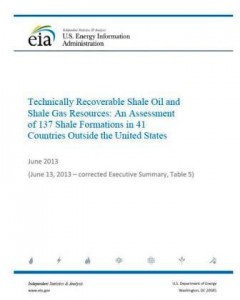
The U.S. Energy Information Administration (EIA) recently released its updated assessment of shale formations outside of the United States. The report, “Technically Recoverable Shale Oil and Shale Gas Resources: An Assessment of 137 Shale Formations in 41 Countries Outside the United States,” was prepared by Advanced Resources International (ARI) and considered 95 basins across the world as compared to the April of 2011 report that assessed 69 shale formations, 48 basins in 32 countries.
The EIA is the statistical and analytical agency within the U.S. Department of Energy. The updated report, which was released this month, was performed so soon after the first report to include shale oil and liquid resources that were not assessed in the first report and as a result of increased well drilling results and advanced geological information on shale plays.
Based on the new assessment, the EIA estimates there are 7,299 trillion cubic feet (TCF) of technically recoverable shale gas and 345 billion barrels (BBL) of shale oil reserves. Technically recoverable resources (TRR) are defined as the volumes of oil and gas that can be produced with current technologies and does not take into account costs, pricing or other economic factors that may limit oil and gas production.
Based on shale gas reserves and EIA estimates, China is leading the way with 1,115 TCF followed by Argentina (802), Algeria (707), the United States (665) and Canada with 573 TCF. Shale oil reserve estimates has Russia with 75 BBL followed by the United States with 58, China 32, Argentina 27 and Libya 26. It is important to note that the report did not include the Middle East, Central Africa and other counties that are expected to have significant shale gas and oil resources.
Putting these new reserve estimates into context, the worldwide consumption of dry natural gas was estimated at 113 TCF in 2010 and oil consumption at 31.2 BBL. Natural gas and oil consumption has rose significantly across the world since 1980 with natural gas demand increasing from 53 TCF and oil consumption from 21.8 BBL. The growth for demand in natural gas has been led by Asia with consumption increasing from 2.2 TCF in 1980 to 19.2 TCF in 2010. Demand in the Middle East has grown from 1.3 TCF to 13.2 TCF over the same period. Natural gas consumption is forecast to increase with an abundant supply and relatively low cost compared to other feedstock coupled with the worldwide industrialization.
The report goes into detail on each shale formation and looks at recovery rates, success rates and other technological factors in evaluating total gas in place and recoverable reserves. It does not take into account the political, social or economic impacts, which may limit or prevent development of the resource. Noted as well is the fact that in many cases the estimates are based on little well data and the ultimate recovery of gas or oil may differ significantly. Since the initial report in April of 2011, several countries have seen their estimates of TRR change substantially. The Ukraine has seen their reserve estimates increase from 42 TCF to 128 TCF, Algeria to 707 TCF from 230 TCF and Canada from 388 TCF to 573 TCF. Many of these increases are due to the addition of new shale basins that were not previously assessed. Some countries have also seen their reserves cut dramatically based on well results including Norway going from 83 TCF to 0 based on poor results in the Alum Shale. France, Libya, South Africa and Mexico have also seen downward revisions on their shale gas estimates in the new study.
Also included in the report is an update on the assessment of the U.S. shale plays looking at potential oil and gas development from shale. The United States has already developed an estimated 37 TCF of shale gas over the past several decades. The report has an overall estimate of 1,161 TCF of risked, technically recoverable wet and dry shale gas from 15 shale basins and 70 plays. A 25 percent recovery factor was used in determining the recovery factor. ARI estimates the United States has 47.7 BBL of oil from 8 shale basins and 35 plays – using a recovery factor of 5 percent. The Marcellus leads the way in remaining natural gas reserves with an estimated 369 TCF followed by the Haynesville with 161 TCF, Eagle Ford 119 TCF and the Utica with 111 TCF. As far as remaining oil reserves, the Bakken/Three Forks has an estimated 14.7 BBL, Eagle Ford 13.6 BBL and the Permian 9.7 BBL.
As evident from the June report, estimates for shale gas and oil not only across the United States, but also the world are changing dramatically. As more wells are drilled, completed and tested agencies such as the EIA are able to provide more accurate estimates on gas and oil reserves. Just in the two years since their initial assessment, the technology has changed allowing for greater recovery of the resources. With the lower domestic price in the United States, more pressure has been placed on increasing recovery rates, maximizing returns, and shifting assets to more profitable plays. A factor that is hard to quantify is the geopolitical and social ramifications that has and will continue to impact shale development.
The complete report can be found on EIA’s Web site.


